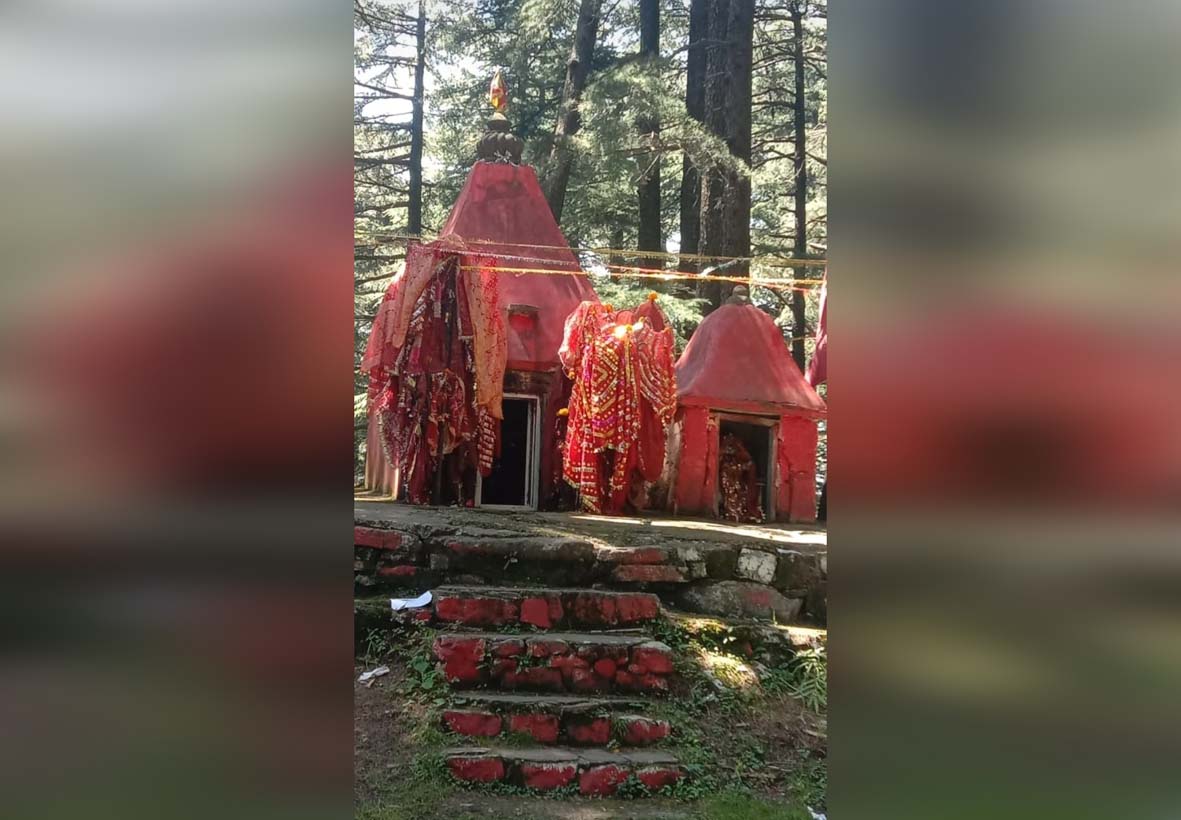Rajinder Chand Anthal
Situated atop a hill in the tranquil meadows of Mantalai, the historic Naina Devi temple is surrounded by lush deodar forests. This area, known as ‘BANDHAR,’ is famous for its unique deodar trees, which were used in the construction of the Singh Garh palace in Chenani. The striking natural beauty of this region makes it a must-see.
The Naina Devi temple can be accessed from three routes: Kossar (ChokaNallah), Mantalai, and Sarar. A three-kilometer trek on the bridal path, laid out by Raja Chenani, connects visitors from Mantalai to the temple. This sacred site was established by the early kings of the Chenani State around the 9th century. Raja Gambhir Chand of the notable Chandel dynasty overcame the local Rana and Thakkar chiefs at the behest of Megh Raja of Mantalai, subsequently founding the Chenani State with Mantalai as its capital. He was the son of the well-known Raja Harihar Chand of Chanderi in Madhya Pradesh, and under the blessings of JawalaMukhi Mata, he and his brothers ruled separate kingdoms in Chenani, Bilaspur, and Kumaon. This shared heritage among the Chandel kings led to the establishment of Naina Devi temples in their respective regions.
It is said that Sudhmahadev and Mantalai were pilgrimage sites for the Holy Devika and Shiv temples long before Raja Gambhir Chand arrived, and the location of the Naina Devi temple carried this name even then.
According to legend, King Daksha had a daughter named Sati, who devoted herself to worshipping Lord Shiva since childhood, hoping to marry him. When Daksha learned of Sati’s wishes, he became enraged and arranged a Swayamvara to marry her off to another king, inviting all the gods but Shiva. To mock Shiva, Daksha placed an idol of him at the main gate of his palace. During the ceremony, Sati garlanded the idol of Lord Shiva, which humiliated Daksha. Following this, Sati prayed to Shiva, who appeared, married her, and took her to Kailash.
Unable to bear the shame and defeat, King Daksha organized a Yagna, again excluding Sati and Shiva. Sati perceived this as a grave insult and implored Shiva to accompany her to the Yagna, but he advised against attending without an invitation. Defying him, Sati went anyway, with Shiva sending his Ganas for her protection. Once there, Daksha insulted Sati before all attendants, leading her to leap into the sacrificial fire, sacrificing herself. In retaliation, Shiva’s Ganas attacked Daksha, and upon Shiva’s arrival, he untied his hair in grief and rage, carrying Sati’s corpse skyward. In the heavens, Shiva performed his destructive Tandava, prompting the gods to fear for their safety. They petitioned Lord Vishnu, who used his Sudarshana Chakra to slice Sati’s body into fifty-one pieces, which scattered across the earth and became fifty-one Shakti Peeths. It is believed that the Naina Devi Temple was established at the site where Sati’s eyes fell. According to religious beliefs, Sati reincarnated as Parvati, born in the Mantalai region as the daughter of Raja Himachal during the Satyuga period. The descendants of Raja Gambhir Chand discovered this location and enshrined the idol of Naina Devi in a small temple, venerating it as their family deity.
For centuries, this temple has been a focal point of faith and worship for the people of Mantalai and surrounding areas. An annual fair is held here every June. Unfortunately, it is disheartening that such a significant religious site with immense tourism potential lacks proper road access, forcing visitors to traverse the mule path established during Chenani’s royal era.
Swami Dhirendra Brahamchari, recognizing the spiritual significance and tourism potential of this location, undertook an aerial survey and later visited via horseback with leading architects from New Delhi. They devised a master plan for its development. Swami bought extensive land in a nearby area to build a helipad, tourist lodging, and a five-star hotel, and established a rough motorable road that attracted many visitors. He also donated a sixty-five-kilogram brass bell to the temple. However, progress stalled after Swami’s tragic death in a plane crash, leading to neglect of the development initiatives he started. The road he constructed fell into disrepair, while our neighboring state of Himachal Pradesh has actively promoted its distant religious sites, drawing thousands of daily pilgrims. It is crucial to execute the tourism development plans crafted by Swami Dhirendra Brahmachari and establish a dedicated authority for the Sudhmahadev-Mantalai pilgrimage circuit to revitalizethe Devika River originating from Dhar Shiv Garh Sudhmahadev.
(The author is a former Zonal Education Officer)


Leave a Reply